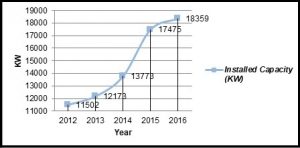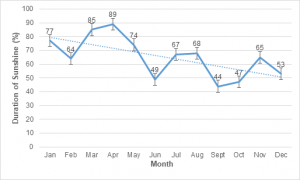By: Akhmad Hanan
The Natuna Islands is a frontier area of Indonesia and a part of Riau Islands Province. The Natuna Islands has 15 subdistricts, which include Midai, Suak Midai, West Bunguran, Bunguran Batubi, North Bunguran, Laut Island, Tiga Island, West Tiga Island, East Bunguran, Northeast Bunguran, Central Bunguran, South Bunguran, Serasan, Subi and East Serasan with the total area of approximately 224,684.59 km2. Based on the data from the Central Bureau of Statistics (2016), the population of the Natuna islands is 75,282, while the electrification ratio is less than 63.2% which is lower than the national electrification ratio of 95.35% (BPS, 2016).
The development of the electricity infrastructures in the Natuna Islands has not increased significantly since 2015. The electricity growth until 2016 is only about 884 kW of installed capacity. Currently, there are only 7 units of electricity infrastructures and 19 supporting power plant machines for the supply of electricity throughout Natuna Islands. The diesel power plants used for powering the electricity is located in Lampa Strait and Ranai and operated by PT PLN Natuna (Rayon). The installed power plants in 2012 were 11.5 MW, with the power capability of 6.7 MW (installed capacity) and 5.7 MW at the peak load (the highest electricity usage at a time). The 11.5 MW power plant capacity is used to meet the demand of the electricity around the Natuna Islands (PLN, 2017).

Figure 1. Electricity Power Installed in the Natuna Islands in 2012 – 2016 (Source: Processed from PT PLN Natuna (Rayon) database, 2017)
Furthermore, the installed capacity in the year 2016 is approximately 18.3 MW (Figure 1). It means there was only an increased installed capacity of 6.8 MW (+59.13%) from the year 2012 to 2016. This increase in electricity ratio is actually higher than the growth rate of the population density in the Natuna Islands. In 2012, the population was 71,454, while in 2016 the population was 75,282. So this means that there was an increased population of 5.1%. In addition to that, the total customers for electricity continue to increase from 9,236 households in 2012 to 14,575 households in 2016 (+57.8%) (Figure 2).

Figure 2. The Number of Household Customers for Electricity (2012 – 2016) in the Natuna Islands (Source: Processed from Central Bureau of Statistics (BPS), 2017)
In the Natuna Islands, households are the largest electricity customer, about 70% compared to other sectors such as small businesses (17%), offices and street lights (8%), schools and mosques (5%). Therefore, the development plan of electricity in the Natuna Islands should prioritize the basic needs of the households while also support other important sectors such as industries.

Figure 3. Percentage of Household Electricity in Natuna Islands (Source: Processed from Central Bureau of Statistics (BPS), 2017)
Figure 3 shows that there was about 96.04% of the households using electricity for their everyday life in 2015 which divided into PLN consumers (79.7%), Non-PLN consumers (16.34%) and 3.96% households have no access to electricity at all. In 2016, the percentage of households who have access to electricity decreased to 94.16%, with 75.19% access coming from PLN and 18.97% access from non-PLN. Meanwhile, the percentage of households without electricity has increased to 5.84% (BPS, Statistik Kesejahteraan Kabupaten Natuna, 2017).
Renewable Energy is the Best Solution on Electricity Development in Natuna Islands
Currently, the main distribution of electricity supply in the Natuna Islands came from PT PLN Natuna (Rayon), using diesel power plants. Given that the output from diesel power plants is not environmentally friendly, it is important to develop energy from renewable sources to fulfill electricity demands in the Natuna Islands. In particular, the Natuna Islands has potential natural resources for generating electricity and one of them is the ocean energy. This type of energy produces current energy, wave energy, and/or tidal energy. For example, the narrow strait between Sabangmawang Island and Setanau Island potentially for current energy with the velocity of 0.738 m/sec can generate 89.2 Watt of electricity (Cahyaningwidi Rahayu Sutopo, Sugianto, & Yosi, 2015). Unfortunately, there have no plans either from the local governments or the central government to develop electricity in the Natuna Islands using renewable energy. The same condition came from both private parties and PT PLN which have no interest in accommodating the application of ocean energy as an electricity source.
The other possibility of renewable energy sources comes from the sun. The Natuna Islands has a total average of 65% of sunshine in a year. For example, in 2017, the intensity of sunshine is quite high with an average of 40% and reaches the peak on April (89% of sunshine intensity) (see Figure 4). Based on the Global Solar Atlas Data, the photovoltaic electricity output in Natuna Island is 3.581 kWh / kWp per day with horizontal radiation of 4.63 kWh / m2 per day (Globar Solar Data, 2018). Moreover, with the support of the Presidential Regulation Number 14 of 2017 which complied to the changes of the Presidential Regulation Number 4 of 2016 on the Acceleration Of Infrastructure Development in Electricity, it should be necessary to build solar panels in remote areas such as in the Natuna Islands.

Figure 4. The Duration of Sunshine in Natuna Islands in 2017
(Source: Meteorological and Geophysical Agency of the Natuna Islands, 2018)
The potential of solar energy in the Natuna Islands is very large. It can be used to power electricity in remote areas or isolated islands such as Laut Island where have no access to the electricity. Although there are some solar panels existed in the Natuna, they are limited to clinics and office districts due to its low capacity. Again, it is necessary to build more solar panels in the Natuna Islands.
As a conclusion, the development of electricity in the Natuna Islands has not yet been optimized. Supports from the central government and the local government to fulfill the electricity demand in Natuna Islands are highly needed. With abundant natural resources in the Natuna Islands, the use of renewable energy can be developed, in particular, the solar energy, for electricity. By using such alternative energy sources in the Natuna Islands, these will indeed support the economic, education, and the other activities in the Islands.
Bibliography
BPS. (2016). Natuna Dalam Angka. Kabupaten Natuna Provinsi Riau: Badan Pusat Statistik Kabupaten Natuna.
BPS. (2017). Statistik Kesejahteraan Kabupaten Natuna. Kabupaten Natuna Provinsi Kepulauan Riau: Badan Pusat Statistik.
Cahyaningwidi Rahayu Sutopo, A., Sugianto, D. N., & Yosi, M. (2015). Potensi Arus Listrik sebagai Sumber Energi di Desa Sabangmawang Natuna. Semarang: Universitas Diponegoro.
Global Solar Data. (2018, 6 3). Retrieved from http://globalsolaratlas.info/?c=4.083453,108.808594,9&s=3.908714,108.387897&m=sg:ghi
PLN. (2017). PT PLN Natuna (Rayon) Database 2017. Ranai: PT PLN.
* This opinion piece is the author(s) own and does not necessarily represent opinions of the Purnomo Yusgiantoro Center (PYC)






